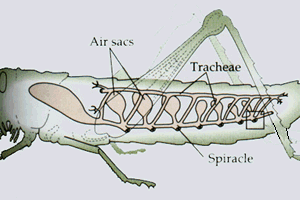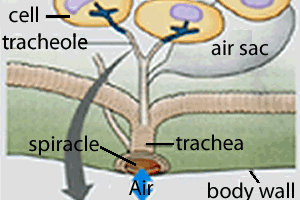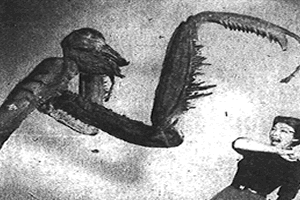
The insect respiratory system is composed of a system of tracheals and in some insects air sacs as well. Tracheals are a series of air filled tubes that run from the edge of the exoskeleton to the tissues deep within the body that often go close to cells or right into cells to deliver O2 very close to the mitochondria. There is usually fluid between the ends of the tracheols and the cells, but as the insect becomes more active the fluid is replaced by air so gas exchange is increased.

Consider the image on the right of electron microscope view of an insect muscle cell. Notice how the tracheoles are close to the mitochondria to minimise the distance through which gases must diffuse.

The use of tracheal systems is superior to using water or blood as mediums of gas exchange because O2 and CO2 diffuse 10,000 times more rapidly in air so the necessary gases can be exchanged more quickly. However, there is a size limit for effective ventilation via a tracheal system, which is one reason that insects cannot grow to great sizes, contrary to some Hollywood movies.

The inner wall surface of the tracheal system is made of the same material that composes the exoskeleton, which helps to prevent water loss. Spiracles, the openings to the outside air, can be opened and closed at will to in regulate air exchange, water loss, and to keep out debris.
AIr movement through the respiratory system is usually accomplished through convection, the mass movement of gases. Some larger insects will use body contractions to expand their body wall to pull air in and push air out of their bodies.